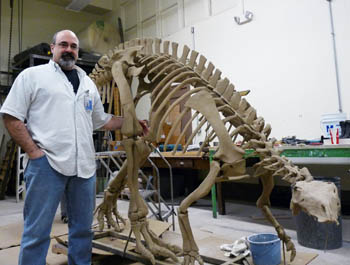 |
|||||
| Politics | Business | Schools | Justice | Health | Et Cetera |
By Steven Mendoza Fourth in an intermittent series of profiles of folks with interesting jobs WASHINGTON - Behind the towering display cases, the pointing fingers and squeals of excitement, there are fossils. A triceratops’ horn wrapped in cellophane. Fossils in small boxes and in protective plaster cases. Tiny pieces lodged in rock, planted under microscopes. Everywhere you look you see more at the vertebrate paleontology preparation lab at the Smithsonian National Museum of Natural History. For 18 years this has been the stamping ground of fossil preparator Steve Jabo, best described as one part artist, one part scientist. His hands, the most valuable tool he owns, work carefully to dig fossils out of the earth, to separate them from the sediment that holds them, to create looming, awe-inspiring displays—and to answer e-mails. Two or three weeks a year Jabo leaves the e-mail behind and travels in search of new specimens. He has been as far as Kazakhstan, primitively camping while excavating ancient mammals. On a recent expedition to the Cloverly Formation in Wyoming, Jabo and several colleagues uncovered the remains of a tenontosaurus, a herbivore from the Early Cretaceous Period. Living 120 million years ago, it could measure 25 feet from head to tail and weigh up to 2,500 pounds. The tenontosaurus foraged in a warmer and wetter Wyoming. Imagine the Pacific Northwest, only warmer, Jabo says. There would have been no mountains and there is evidence of an inland sea extending from the north, effectively separating the United States into two distinct land masses. Working to separate the fossils from the surrounding matrix of sediment and rock is a painstaking process, but it is only the first step. Jabo also has to try and put fossils back together, piece by piece, like a jigsaw puzzle. The goal is not to clean and assemble the remains so they can be put on display, but to make them available for researchers from around the world to form and test their theories, he says. “A museum is not about exhibits, in my mind,” Jabo says. Imagine the museum as a giant reference library, he says, displaying a few impressive books from its collection. But behind the walls there are masses more. “What you see on exhibit is just the most minute fraction of the actual specimens that we have,” he says. “We have rows and rows and stacks and stacks of fossils and other natural history specimens that people from all over the world come to study or to borrow,” he says. “To me, the [exhibits are] secondary to the actual research.” He says the museum is home to hundreds of thousands of vertebrate specimens. His hometown of Warren, Pa., is home to just over 10,000 people. Growing up in rural western Pennsylvania, Jabo, 47, wasn’t one of those kids who always wanted to be an astronaut or a physician. He just liked the outdoors. “I grew up hunting and fishing … so I would maybe just take off and go fishing all day, even camp out and go fishing.” He graduated from Penn State with a Bachelor of Science degree in bio-geology, but it took some time for him to distill his skills and interests into a job description that existed, he says. Before coming to the museum he surveyed for oil and gas and was a geologist for an environmental firm that cleaned up Superfund sites. Those jobs can’t hold a candle to his current gig. “If they did, I’d still be there,” says the Arlington, Va., resident. Matt Carrano, curator of dinosaurs at the museum and Jabo’s supervisor, says those other jobs gave Jabo invaluable experience that has really contributed to their field work. “He’s a great guy to have in the field because ... he knows how to deal with vehicles, knows how to build crates for shipping fossils” and knows how to read geological and typographic maps, Carrano says. “I like working with my hands, and so for me, it’s a perfect match of, you know being able to do field work and then come back and do the creative hand work that goes along with it,” Jabo says. |
||||||||
Copyright © 2009 University of Maryland Philip Merrill College of Journalism |
||||||||
| Politics | Business | Schools | Justice | Health | Et Cetera | |||
